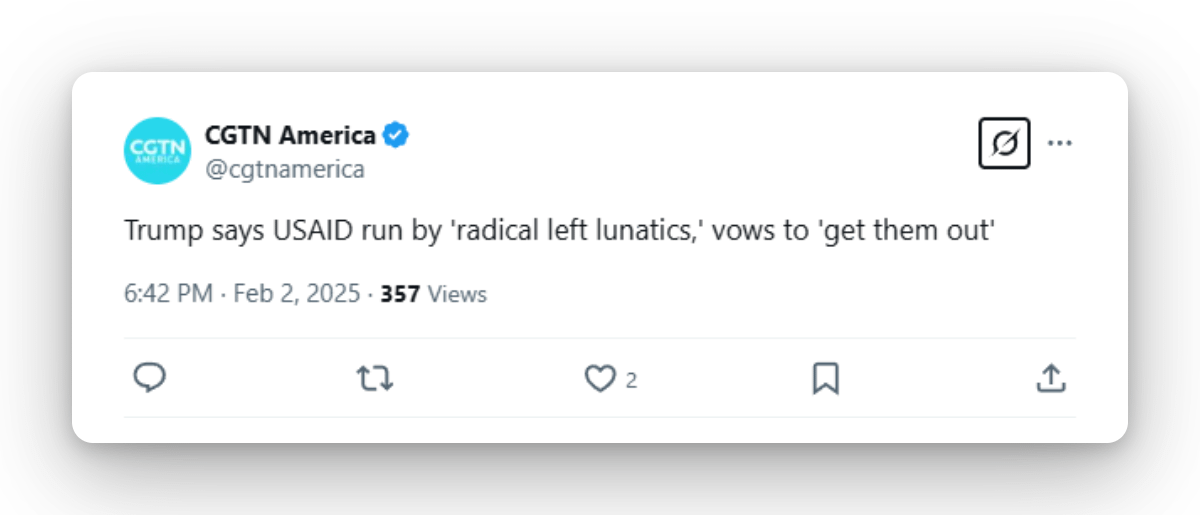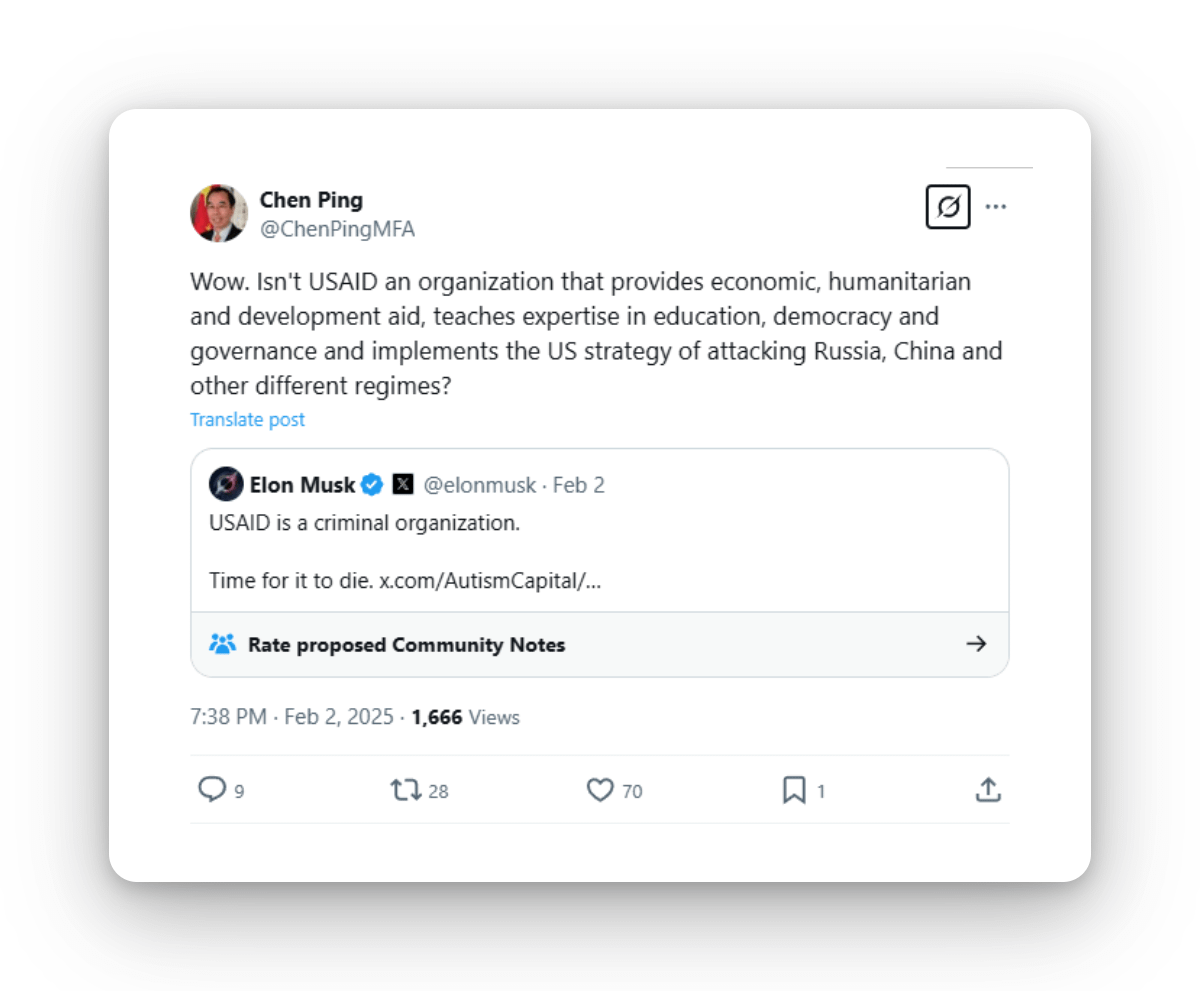The suspension of USAID operations has created a vacuum in global development assistance. China appears to be filling this void using state-controlled development, humanitarian aid, educational programs, and influence campaigns to strengthen its geopolitical standing.
China’s post-USAID strategy is multifaceted. It combines hard investment in infrastructure and development with soft-power operations. The approach prioritizes regional dominance, ideological alignment, and the suppression of independent monitoring.
Partnerships in regions like the Cook Islands, Cambodia, and Rwanda are not just humanitarian; they are long-term positioning plays for resource control (deep-sea mining, agriculture, and health infrastructure).
Human rights monitors and China watchers have reported being approached by individuals who are understood to represent China with funding offers. Accepting the aid would require them to cease public criticism of China.
China—along with Russia, Hungary, Serbia, and Slovakia—has used allegations about foreign-funded influence to discredit and, in some cases, investigate independent groups and media organizations. This appears to be a case of political adoption, where actors seize upon advantageous claims from elsewhere. China’s intimidation of individuals abroad has only been emboldened by USAID’s retreat.
While it’s unclear exactly how much of this funding has been cut permanently, the damage is already visible, and key partners, like Australia, are worried. Organizations have been forced to lay off employees or shut down entirely. The situation is not simply about China filling gaps left by the United States.
The Cook Islands, through Dean Yarrall, vice chairperson of the Pacific Energy Regulators Alliance, expressed concern and disappointmentover USAID’s abrupt shutdown. He emphasized that USAID had been a significant regional supporter and that its sudden withdrawal created a vacuum. He pointed out growing competition for influence in the Pacific, mentioning China and Australia, and highlighted that the U.S. stepping back could have serious geopolitical consequences.
China’s expansion continues regardless of U.S. presence but is now advancing against U.S. withdrawal. The contrast is sharper because the United States had planned to confront these challenges directly through what is now a gutted agency.
The 2025 USAID budget outlined:
$2.1 billion in discretionary funding for regional partnerships, governance, and security cooperation across the Indo-Pacific.
$2 billion in mandatory funding over five years to promote economic stability and democratic institutions.
$400 million for the Countering the People’s Republic of China (PRC) Influence Fund to address specific PRC behaviors and strengthen U.S. allies’ resilience to coercion.
$4.1 billion for programming aligned with the Partnership for Global Infrastructure and Investment (PGII), aimed at advancing strategic infrastructure in priority sectors, including climate, health security, digital connectivity, transportation, and agriculture.
$250 million for the PGII Fund to respond to urgent infrastructure needs, remove barriers, and build consortiums to compete for global projects.
$2 billion over five years for an International Infrastructure Fund (IIF) designed to offer credible alternatives to the PRC’s state-directed infrastructure financing.
Examples of programs countering Chinese influence:
USAID’s role in helping a Western consortium outbid China for control of the Lobito Corridor, securing access to critical minerals and blocking Beijing from monopolizing a key supply chain that would have granted strategic leverage over global markets.
USAID advanced plans and allocated funding for the Luzon Economic Corridor, an infrastructure initiative linking Subic Bay, Clark, Manila, and Batangas.
USAID supports AidData, which provides critical open-source intelligence on Chinese “hidden debt” and development financing—indispensable for policymakers countering Chinese economic coercion globally.
In Palau, USAID funded a second submarine cable free of CCP influence after Chinese vessels were observed threatening existing infrastructure.
What remains is not just a funding vacuum but a diminished presence. China continues to show up—with money, sustained programming, and diplomatic outreach—while the United States steps back. That absence, not just the dollars, is what erodes influence.
Nowhere is this erosion more consequential than in Taiwan. While military deterrence garners headlines, Taiwan’s diplomatic survival depends heavily on relationships built through development partnerships. USAID has been a quiet but critical part of this effort. In 2022, the American Institute in Taiwan (AIT) and the Taipei Economic and Cultural Representative Office (TECRO) formalized cooperation between USAID and Taiwan’s International Cooperation and Development Fund (TaiwanICDF), focusing on joint development projects in humanitarian aid, climate resilience, and economic development.
With USAID suspended, these countries are more vulnerable to Chinese financial overtures. Paraguay, another key Taiwanese ally in Latin America, has similarly relied on USAID and TaiwanICDF to support micro, small, and medium-sized enterprises as part of broader economic and governance stability efforts. Beijing’s ability to lure Paraguay becomes far more potent without that backing.
Shutting down USAID removes a strategic counterweight to China’s diplomatic isolation campaign against Taiwan. The damage reaches beyond humanitarian disruption—it weakens alliances and undercuts U.S. influence exactly where it is most needed.
Regional Actions
North America
United States: China has begun advertising positions and funding for scientists displaced by funding cuts. Top Chinese universities are aggressively recruiting Chinese undergraduates abroad to skip traditional academic pathways and enrol directly into PhD programmes – as the U.S. tightens funding for graduate studies and geopolitical tensions grow. Analysts say the move reflects a push to lure young academics from the United States.
Recent U.S. legislation framed as a national security measure may inadvertently aid China’s efforts by banning Chinese nationals from studying in the United States. While legitimate security concerns exist with some foreign nationals, the opportunity to live and study in the U.S. often helps dispel misconceptions and foster relationships that reduce the likelihood of future conflict. Such legislation is all the more self-defeating when individuals with financial ties to China exercise an outsized influence on the current administration.
Latin America
- China has significantly increased development assistance throughout Latin America. With 22 signatories to the Belt and Road Initiative in the region, China is actively converting financial support into diplomatic leverage. This approach focuses on infrastructure investment and long-term strategic partnerships.
South and Central Asia
Kazakhstan: Increased education and civil society programming funding to deepen regional ties.
Nepal: China has offered informal assurances of support in humanitarian aid, health, and education. Under the Health Silk Road initiative, China established a blindness prevention center.
Africa
Nigeria: China EXIM and UNICEF collaboration to provide life-saving services to vulnerable children.
Ethiopia: A $4 million healthcare contribution to the Africa CDC, in partnership with Korea.
Somalia: Somalia’s Ministry of Fisheries highlights Chinese training and financial assistance in fisheries management and aquaculture. The country seeks long-term investment to harness its coastline’s potential, with projections of 150,000 metric tons of fish production annually, potentially contributing billions to GDP.
Lesotho: Delivery of 810 tons of rice and wheat valued at $1.37 million.
Senegal: China Media Group (CMG) hosted a major dialogue in Dakar, Senegal. The event gathered political, business, academic, and media leaders to discuss how Chinese modernization could create new opportunities for Africa. It is part of CMG’s “China in Spring Time: Sharing Opportunities with the World” Global Dialogue series.
The Pacific Islands
Cook Islands: A comprehensive strategic partnership agreement focusing on deep-sea mining, infrastructure, and economic development.
Fiji: Deployment of experts to assist in poverty reduction planning and policy development.
Southeast Asia
Cambodia: China has stepped in with significant development and demilitarization assistance, including a $4.4 million grant for mine clearance operations and investment proposals for agro-industrial development zones. Notably, the region requires demining due to U.S. military operations.
Myanmar: China continues to exert undue influence, especially in the aftermath of the U.S. withdrawal, via the China-Myanmar Economic Corridor.
The Middle East
- Palestine: China has pledged food packages for 60,000 families.
Tibet and Hong Kong
Tibet: Education programs are under threat due to the loss of U.S. funding, with China taking advantage of weakened external support.
Hong Kong: Chinese authorities have increased their scrutiny of political parties allegedly reliant on foreign funding, reinforcing narratives about foreign interference.
Influence Operations
Chinese state media outlets have churned out negative content framing USAID as a “brainwash machine” and “lie factory” that “gaslit” other countries. Chinese officials have praised President Donald Trump and Elon Musk for their actions in “dismantling” USAID. Chinese officials echoed the unsubstantiated claims about “fraud and abuse.”
The termination of U.S. support for organizations focused on China has crippled the monitoring of human rights abuses. Some organizations have reported China attempting to fill the funding void, presumably with the expectation that they would cease public criticism.
The Chinese state media and official narratives are actively undermining foreign-funded research institutions in countries like Australia, presenting them as fabricators of disinformation.
Citation
@article{li2025,
author = {Li, E. Rosalie},
publisher = {Information Epidemiology Lab},
title = {Aid, {Trade,} \& {Shade:} {China’s} {USAID} {Ambitions}},
journal = {InfoEpi Lab},
date = {2025-03-20},
url = {https://infoepi.org/posts/2025/03/aid-trade-shade-china-usaid.html},
langid = {en}
}
